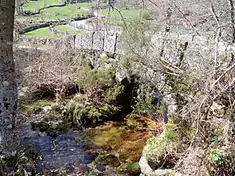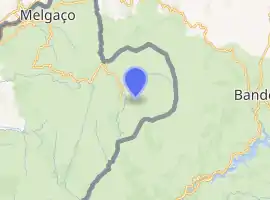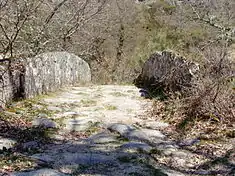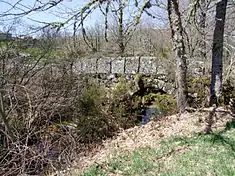Ponte das Caínheiras
Ponte das Caínheiras is a masonry bridge in the civil parish of Castro Laboreiro e Lamas de Mouro, municipality of Melgaço, in the district of Viana do Castelo, on the narrow traffic area over the Rio das Caínheiras.
Bridge of Caínheiras Ponte das Caínheiras | |
|---|---|
 View of the small Romanesque bridge over the Rio das Caínheiras | |
| Coordinates | 42.025665°N 8.138821°W |
| Carries | Vehicles and Pedestrians |
| Crosses | Rio das Caínheiras |
| Locale | |
| Official name | Ponte sobre o Rio das Caínheiras |
| Other name(s) | O Diabo |
| Heritage status | Property of Public Interest |
| Characteristics | |
| Material | Granite |
| Location | |

| |
Locals often refer to the bridge as "O Diabo" (The Devil) owing to the frequent traffic tie-ups attempting to cross it.
History


The first reference to the bridge occurred on 11 May 1758 by Father Inácio Ribeiro Marques, in the Memórias Paroquiais of the parish.[1] It is likely that the bridge was constructed at the end of the 18th century or beginning of the 19th century.[1]
Architecture
The bridge is situated in a rural area harmoniously implanted within the Peneda-Gerês National Park.[1] It is erected 160 metres (520 ft) northwest of the winter pasturelands of Cainheiras, over the river Cainheiras, at about 970 metres (3,180 ft) above cultivatable and forested lands.[1] It is located some 2 kilometres (1.2 mi) from the chapel of Senhora da Boavista and 4 kilometres (2.5 mi) from the chapel of Senhora de Anamão.[1] The bridge of Cainheiras is part of a network of vicinal roads south and east of Castro Laboreiro, in addition to the Minhoto-Galacia regional roadways that connected Castro Laboreiro with Melgaço, Arcos de Valdevez and Bande.[1] Further, it connected Castro Laboreiro with Galicia to the east, in the direction of Celanova (through Portos and Seara) and south towards Entrimo and Lobios (through Ameixoeira).[1]
It is an arched bridge, with soft incline, over two arcs with long, regular staves, reinforced by triangular cutwaters.[1] On the ramp are large rectangular stone blocks that act as railing.[1] It is proceeded by a gentle incline from a curvilinear bend in the road on both sides.[1] The arches are slightly uneven with a 3 metres (9.8 ft) diameter, supported by long, regular staves. Between either arch are reinforcements: upstream, triangular cutwater and, downstream, rectangular struts. The ramp slabs are protected by guardrails formed by large blocks, reinforced by iron "staples".[1]
References
Notes
- Noé, Paula (1992), SIPA (ed.), Ponte das Cainheiras (IPA.00000436/PT011603020014) (in Portuguese), Lisbon, Portugal: SIPA – Sistema de Informação para o Património Arquitectónico, retrieved 8 March 2016
Sources
- Almeida, Carlos Alberto Ferreira de (1987), Alto Minho (in Portuguese), Lisbon, Portugal: Editorial Presença
- Araújo, José Rosa de (1962), Caminhos velhos e Pontes de Viana e Ponte de Lima (in Portuguese), Viana do Castelo, Portugal
- Capela, José Viriato (2005), As freguesias do distrito de Viana do Castelo nas Memórias Paroquiais de 1758 (in Portuguese), Braga, Portugal: Casa Museu de Monção/Universidade do Minho
- Fontes, Luis, Ponte das Cainheiras (in Portuguese), retrieved 8 September 2015
- Rodrigues, Aníbal (1985), Pontes Romanas e Românicas de Castro Laboreiro, Melgaço (in Portuguese), Melgaço, Portugal: Câmara Municipal de Melgaço
- S.A. (ed.), "Seis Pontes Classificadas em Castro Laboreiro", O Diário (in Portuguese), Lisbon, Portugal